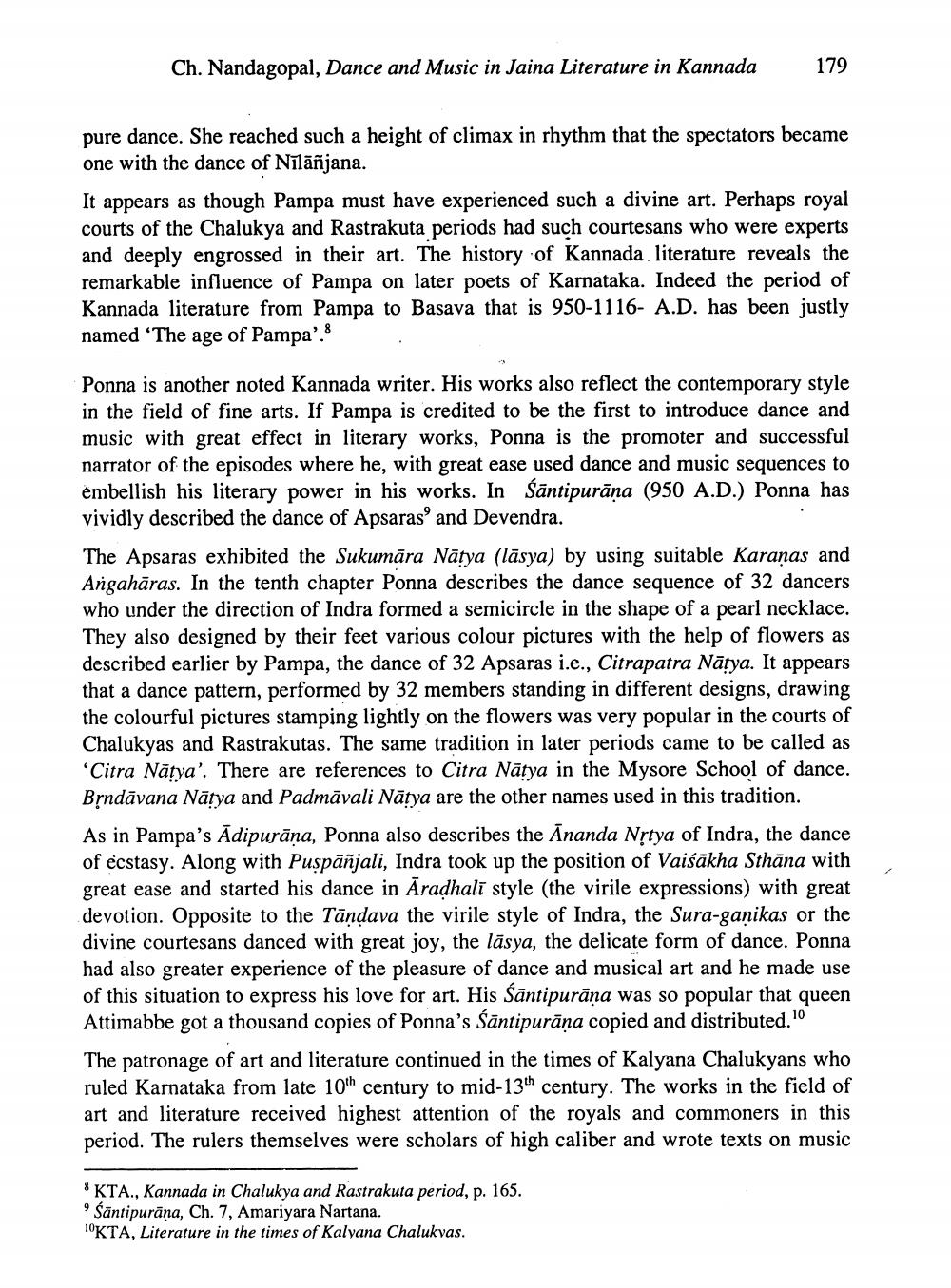________________
Ch. Nandagopal, Dance and Music in Jaina Literature in Kannada 179
pure dance. She reached such a height of climax in rhythm that the spectators became one with the dance of Nīlāñjana.
It appears as though Pampa must have experienced such a divine art. Perhaps royal courts of the Chalukya and Rastrakuta periods had such courtesans who were experts and deeply engrossed in their art. The history of Kannada literature reveals the remarkable influence of Pampa on later poets of Karnataka. Indeed the period of Kannada literature from Pampa to Basava that is 950-1116- A.D. has been justly named "The age of Pampa".
Ponna is another noted Kannada writer. His works also reflect the contemporary style in the field of fine arts. If Pampa is credited to be the first to introduce dance and music with great effect in literary works, Ponna is the promoter and successful narrator of the episodes where he, with great ease used dance and music sequences to embellish his literary power in his works. In Säntipuräna (950 A.D.) Ponna has vividly described the dance of Apsaras" and Devendra.
The Apsaras exhibited the Sukumāra Natya (lāsya) by using suitable Karanas and Angahāras. In the tenth chapter Ponna describes the dance sequence of 32 dancers who under the direction of Indra formed a semicircle in the shape of a pearl necklace. They also designed by their feet various colour pictures with the help of flowers as described earlier by Pampa, the dance of 32 Apsaras i.e., Citrapatra Natya. It appears that a dance pattern, performed by 32 members standing in different designs, drawing the colourful pictures stamping lightly on the flowers was very popular in the courts of Chalukyas and Rastrakutas. The same tradition in later periods came to be called as 'Citra Natya'. There are references to Citra Natya in the Mysore School of dance. Bṛndāvana Natya and Padmavali Natya are the other names used in this tradition.
As in Pampa's Adipurāṇa, Ponna also describes the Ananda Nṛtya of Indra, the dance of ecstasy. Along with Puspäñjali, Indra took up the position of Vaiśākha Sthāna with great ease and started his dance in Aradhali style (the virile expressions) with great devotion. Opposite to the Tandava the virile style of Indra, the Sura-ganikas or the divine courtesans danced with great joy, the läsya, the delicate form of dance. Ponna had also greater experience of the pleasure of dance and musical art and he made use of this situation to express his love for art. His Santipurāṇa was so popular that queen Attimabbe got a thousand copies of Ponna's Santipurāna copied and distributed."
The patronage of art and literature continued in the times of Kalyana Chalukyans who ruled Karnataka from late 10th century to mid-13th century. The works in the field of art and literature received highest attention of the royals and commoners in this period. The rulers themselves were scholars of high caliber and wrote texts on music
KTA., Kannada in Chalukya and Rastrakuta period, p. 165. Santipurana, Ch. 7, Amariyara Nartana.
10KTA, Literature in the times of Kalyana Chalukyas.




